Standard [CURRENT]
ASTM E 3379:2025
Standard Guide for Critical Airflow Visualization
- Publication date
- 2025
- Original language
- English
- Pages
- 9
- Publication date
- 2025
- Original language
- English
- Pages
- 9
- DOI
- https://dx.doi.org/10.1520/E3379-25
Product information on this site:
Quick delivery via download or delivery service
Buy securely with a credit card or pay upon receipt of invoice
All transactions are encrypted
Short description
1.1 This guide is intended to provide best practices on how to visualize airflow in a critical area and be read in conjunction with relevant International Organization for Standardization (ISO), U.S. Food and Drug Administration (FDA), and EudraLex requirements for airflow visualization. 1.2 In this guide, the airflow visualization test (that is, smoke study) is detailed for use to understand and document airflow patterns for critical airflow environments. This test evaluates the contamination control effect of high-efficiency particulate air (HEPA)-filtered airflow, which is the basis for the contamination control effect of critical zones. 1.3 The focus of this guide is on contamination control and is not intended to evaluate airflow for operator protection when handling potential high-risk biological agents and potent, toxic, and other hazardous materials. 1.4 Areas utilizing airflow to control contamination of critical product surfaces should be evaluated visually as part of qualification. 1.4.1 Critical airflow studies are intended to verify the unidirectional nature of "first-pass air" released from HEPA filters and demonstrate its capability of minimizing the risk of contamination. Smoke studies use a visual medium (that is, tracer particles) to observe airflow patterns. The generator chosen should produce constant, neutrally buoyant, and non-toxic tracer particles/smoke. 1.5 Information from this evaluation can be used to compare the actual (physical) airflow patterns versus design and regulatory requirements, optimize airflow patterns for improved contamination control effect, evaluate operator and equipment movements impact on airflow patterns, aid in risk assessment, determine environmental monitoring sample locations, and assist in operator training. Out of scope is airflow visualization activities for investigational purposes and optimization purposes, which will have evaluation criteria associated with them. 1.6 Units- The values stated in SI units are to be regarded as the standard. No other units of measurement are included in this standard. 1.7 This standard does not purport to address all of the safety concerns, if any, associated with its use. It is the responsibility of the user of this standard to establish appropriate safety, health, and environmental practices and determine the applicability of regulatory limitations prior to use. 1.8 This international standard was developed in accordance with internationally recognized principles on standardization established in the Decision on Principles for the Development of International Standards, Guides and Recommendations issued by the World Trade Organization Technical Barriers to Trade (TBT) Committee.
ICS
13.040.01
DOI
https://dx.doi.org/10.1520/E3379-25
Also available in
Loading recommended items...
Loading recommended items...
Loading recommended items...
Loading recommended items...

